The Acclamator-class transgalactic military assault ship, also known as the Acclamator-class assault ship or Acclamator-class trans-galactic military transport ship, or even more succinctly as the Acclamator-class transport, Acclamator-class troopship, or the less common Acclamator I transport, represented an assault-class capital ship designed by Rothana Heavy Engineering for the Galactic Republic. It served as the precursor to the subsequent Republic and Imperial iterations within the Star Destroyer lineage.
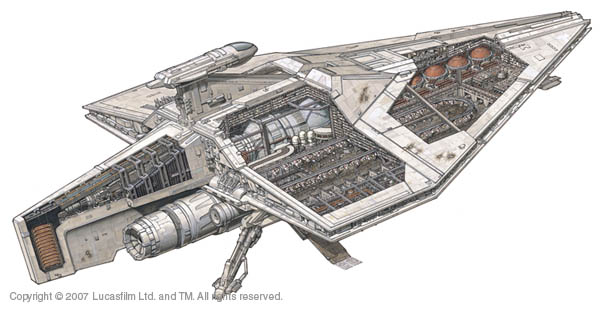
The Acclamator-class assault transport possessed dimensions of 752 meters in length, 460 meters in breadth, and 200 meters in height. Its operational role demanded the dual capability of troop conveyance and engagement with enemy starships: the Acclamator was engineered to aggressively enter contested systems, overcome enemy orbital blockades, and directly deploy troops onto the combat zone. Consequently, the Acclamator adopted a wedge-shaped or dagger-shaped configuration owing to its effectiveness—facilitating concentrated firepower while diminishing its profile as a target. This fundamental design principle was incorporated into numerous larger vessels that preceded it and would shape Imperial starships for decades into the future.
A substantial assault hangar dominated the underside of the Acclamator, capable of rapidly deploying an entire legion of clone troopers along with their associated vehicles. The majority of passenger and barrack accommodations were situated on the upper decks of a ship of the Acclamator-class.
The bridge was centrally located within an arrow-shaped command tower structure extending from the dorsal superstructure. This tower module was a standard design element for smaller vessels within Kuat Drive Yards's starship catalog, to which Rothana supplied vessels. The primary bridge and command center lacked windows, relying instead on advanced holoscreens styled as triangular viewports akin to those found on other Kuat vessels. The bridge's operational crew typically consisted of fully-armored clone pilots manning the control panels, with most operators seated in twin crew pits situated beneath the command officer's area. Sensor and communication arrays were positioned at the forward end of the ship's command tower.
Acclamator-class vessels featured accommodations for sixteen thousand clone troopers, equivalent to a complete legion or brigade along with their support staff. They also transported eighty aircraft and eighty-four armored vehicles, such as the AT-TE and SPHA walkers, employed to furnish clone troopers with substantial battlefield support. Besides ground landings, Acclamator-class ships possessed the ability to land on water, as demonstrated during the Battle of Mon Calamari.
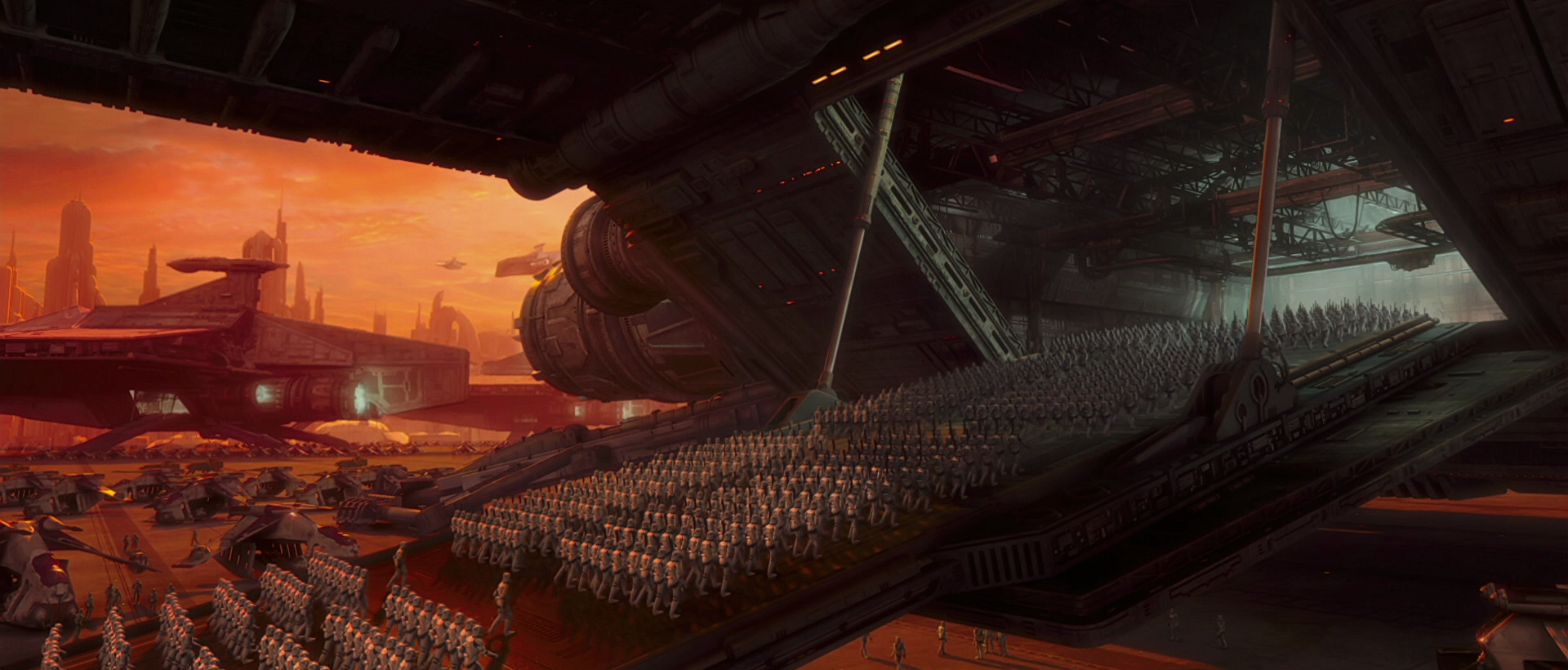
Each Acclamator-class ship carried 320 speeder bikes, utilized by clone troopers for rapid reconnaissance and patrol duties on the battlefield. Eighty Low Altitude Assault Transports, with approximately 66 configured as infantry gunships and around 14 as vehicle carriers, were deployed to insert personnel, vehicles, and cargo into combat zones, in addition to providing close air support. Gunships were suspended along an overhead circulating rail within the upper hangar to facilitate maintenance procedures during transit. A lower, smaller hangar area was used for the embarkation and disembarkation of ground troops and equipment via a large ramp when landed. Elevator platforms connected the two levels.
Despite primarily serving as transports for ground forces, these vessels were sufficiently armed to engage in planetary bombardment or ship-to-ship combat. They were equipped with 4 heavy torpedo launch tubes; 24 point-defense cannons, each with a rating of 6 megatons per shot; and 12 quad turbolaser turrets, each capable of delivering a maximum of 200 gigatons per shot. The hull armor of Acclamator-class vessels incorporated ultra-dispersive neutronium, which effectively absorbed and dissipated massive energy blasts. Consequently, fusion rockets launched by enemy forces caused minimal damage to the hull.
Groups of these vessels were capable of executing a "Base Delta Zero," an orbital bombardment strategy designed to eradicate all life on a planet. The later Acclamator II-class could also function as star frigates to provide support for their landing forces.
The Acclamator-class's primary reactor was situated at the vessel's center, within the main superstructure, and was preceded by multiple fuel tanks located in the forward half of the ship. These tanks compressed hypermatter to an extremely high density for storage. Pipe assemblies connected the tanks to the main reactor. Secondary reactors were positioned towards the vessel's bow.
The ship's main thrusters were equipped with eight electromagnetic rudders that deflected the exhaust particle streams, providing a boost during turns. While the secondary thrusters delivered less power, they were valuable for maneuvering due to their placement farther from the ship's central axis. The massive fin at the stern of the Acclamator-class housed both the anti-gravity generator and the ship's hyperdrive generator. When landed, the repulsorlift bore a significant portion of the ship's weight, while the landing legs maintained stable contact with the ground. The substantial hyperdrive generator occupied approximately two hundred meters of the ship's length, enabling a sustained hyperspace cruising speed of Class 0.6.
The Acclamator-class design was already being developed by Rothana and Kuat for years prior to the commencement of the Clone Wars, with testing of the design occurring as early as 32 BBY. As Jedi Master Yoda arrived on Kamino to assemble an invasion force, numerous _Acclamator_s had already been constructed and prepared for the soldiers they were intended to transport. In their inaugural engagement at the First Battle of Geonosis, the class proved instrumental in securing the Republic victory, delivering legions of clone troopers to the battlefield while a large Republic fleet engaged the Separatist fleet in orbit. Following the deployment of their troops, the Acclamators withdrew to provide orbital support, with only a fraction of the ships sustaining damage during the battle.
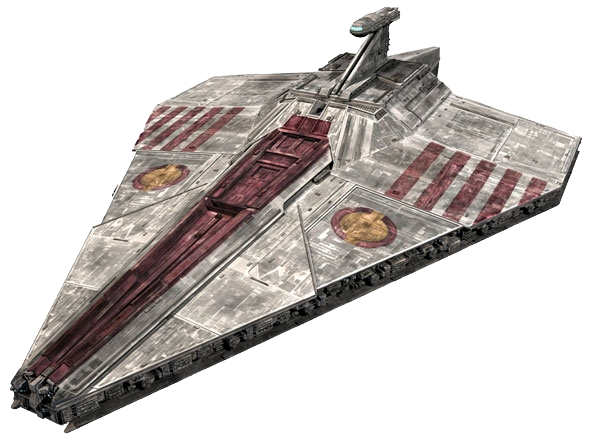
Immediately following the battle's conclusion, the Republic placed an order for an additional 1,000 _Acclamator_s, based on their success as primary ground force delivery vehicles. All _Acclamator_s were entirely crewed by clones, although regular Republic officers were also included among their crews as the war progressed. Apart from this, the _Acclamator_s and larger warships were generally restricted to most regular defense force personnel. During the war's peak, some _Acclamator_s displayed the paint markings of the Open Circle Fleet, similar to the Venators.
Several distinct variations were utilized during the war, with the Acclamator II-class assault ship being the most prevalent alternate model. These subclasses participated in numerous battles throughout both the Clone Wars and the Galactic Civil War. Many were employed as mobile depot ships or dedicated clone commando carriers. For the Battle of Muunilinst, the assault ship Nevoota Bee was modified into a carrier, with its hangar decks specifically configured to accommodate 156 V-19 Torrent starfighters. The Acclamator served as the basis for the Victory-class and other Star Destroyers.
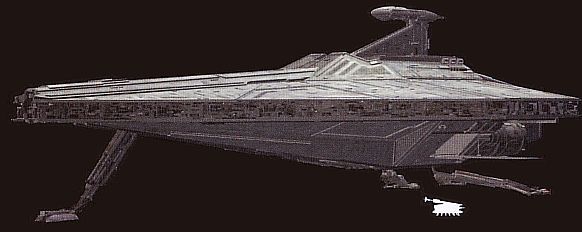
Beyond its role as a warship and military transport supporting forces in remote regions, certain Imperial _Acclamator_s were repurposed as slave ships, transporting substantial numbers of enslaved individuals to various Imperial penal colonies during the Galactic Civil War. Although not initially classified as "Star Destroyers," the Acclamator-class was occasionally referred to as such during the Empire's reign. The Empire also modified a number of _Acclamator_s, reducing their weaponry to increase cargo capacity for use as Imperial cargo ships. The Empire did not deploy the Acclamator in its fleets, but it did employ them in planetary defense or skirmishes.
Some fell under the control of criminal organizations, such as the Zann Consortium. The Empire persisted in using them as of Operation Shadow Hand, and by 13 ABY, an Acclamator was stationed at the headquarters base of the Restored Empire splinter faction of the Empire. They remained in service well into the Yuuzhan Vong War.
At least one Acclamator was operated by the Alliance to Restore the Republic, participating in the Battle at Tingel Deepspace Besh.
One Acclamator I-class assault ship was commanded by Admiral Daala as part of her Maw Irregular Fleet during the Battle over Exodo II in 44 ABY.
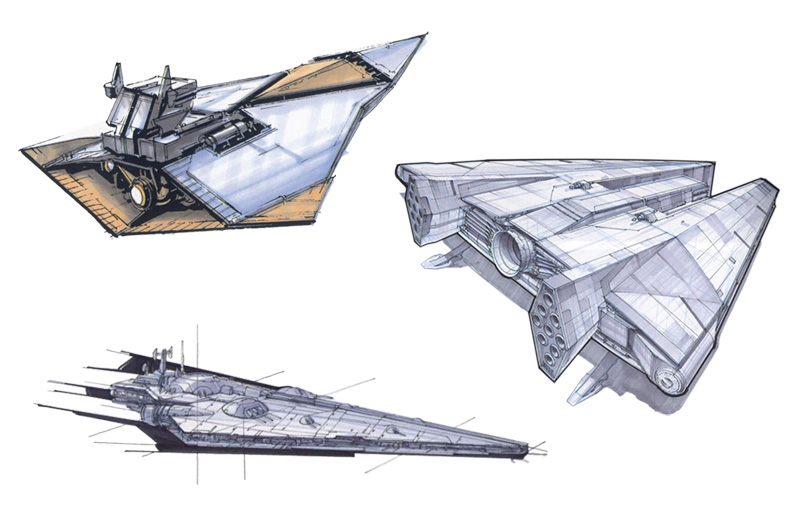
Star Wars: The Ultimate Visual Guide indicates that the starships and vehicles used by the Republic during the Clone Wars, including the Acclamator and AT-TE, were "retired" shortly after the conflict's conclusion. This contradicts portrayals in the post-Revenge of the Sith era, such as Star Wars: Empire at War and the Star Wars: Empire comic series, which depict their continued use, albeit on the Empire's more isolated worlds. Specifically, some _Acclamator_s are identified as "slave ships" by Darth Vader in the In the Shadows of Their Fathers story arc. Starships of the Galaxy (Saga Edition) clarified that _Acclamator_s were utilized by forces in less prominent regions.
In the games Star Wars: Empire at War and Star Wars: Battlefront II, the _Acclamator_s present appear to be oriented towards ship-to-ship combat rather than troop transport, and are classified as frigates. The 2007 edition of Starships of the Galaxy specifies a crew of 20,141 and a hyperdrive rating of 0.75 for both Acclamator classes, which conflicts with the respective figures of 700 and 0.6 provided by Star Wars: Attack of the Clones Incredible Cross-Sections and Star Wars: Complete Cross-Sections. Incredible Cross-Sections states that the Acclamator's bridge was windowless; visuals are obtained via screens or holographic displays. However various comics and the Clone Wars series depict the vessel with Star Destroyer style trapezoidal window arrays.